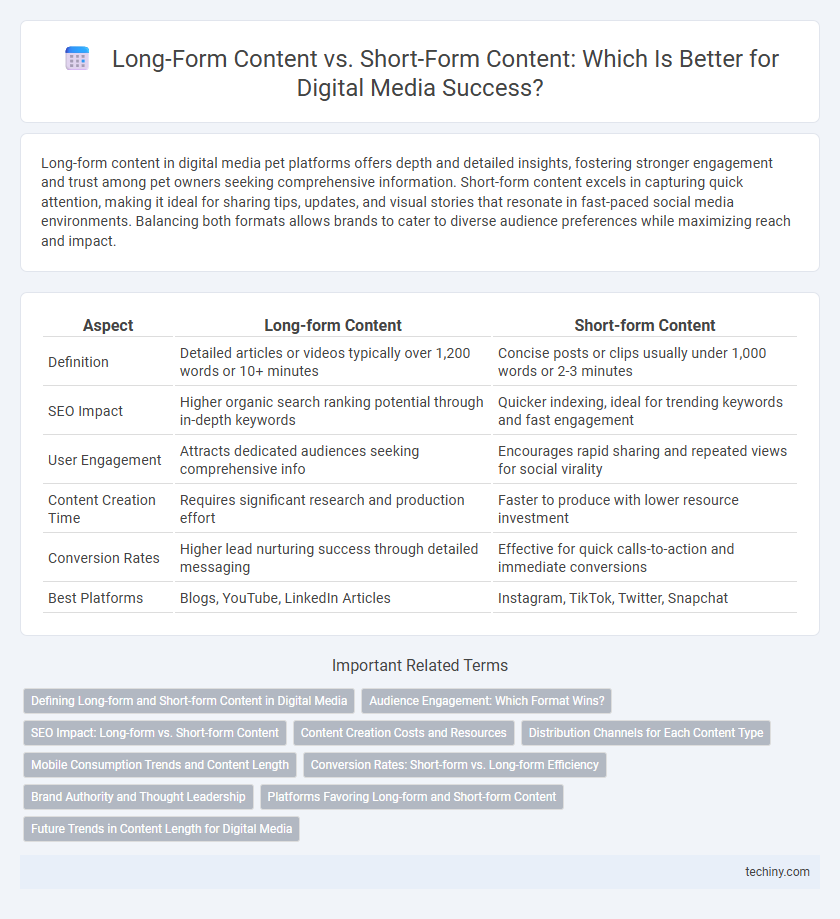Long-form content in digital media pet platforms offers depth and detailed insights, fostering stronger engagement and trust among pet owners seeking comprehensive information. Short-form content excels in capturing quick attention, making it ideal for sharing tips, updates, and visual stories that resonate in fast-paced social media environments. Balancing both formats allows brands to cater to diverse audience preferences while maximizing reach and impact.
Table of Comparison
| Aspect | Long-form Content | Short-form Content |
|---|---|---|
| Definition | Detailed articles or videos typically over 1,200 words or 10+ minutes | Concise posts or clips usually under 1,000 words or 2-3 minutes |
| SEO Impact | Higher organic search ranking potential through in-depth keywords | Quicker indexing, ideal for trending keywords and fast engagement |
| User Engagement | Attracts dedicated audiences seeking comprehensive info | Encourages rapid sharing and repeated views for social virality |
| Content Creation Time | Requires significant research and production effort | Faster to produce with lower resource investment |
| Conversion Rates | Higher lead nurturing success through detailed messaging | Effective for quick calls-to-action and immediate conversions |
| Best Platforms | Blogs, YouTube, LinkedIn Articles | Instagram, TikTok, Twitter, Snapchat |
Defining Long-form and Short-form Content in Digital Media
Long-form content in digital media typically refers to articles, videos, or posts exceeding 1,200 words or lasting over 10 minutes, designed to provide comprehensive information and in-depth analysis. Short-form content includes posts, videos, or messages under 1,200 words or shorter than 10 minutes, aiming to deliver quick, concise information or entertainment. Both content types serve different purposes in engagement strategies, with long-form enhancing SEO and authority, while short-form excels in rapid consumption and social sharing.
Audience Engagement: Which Format Wins?
Long-form content drives deeper audience engagement by providing comprehensive information that builds trust and encourages longer site visits, increasing user interaction and retention. Short-form content captures attention quickly and is ideal for social media platforms, generating rapid shares and high-volume impressions that boost brand visibility. The optimal choice depends on target audience preferences, with long-form suited for in-depth learning audiences and short-form excelling in fast-paced, mobile scrolling environments.
SEO Impact: Long-form vs. Short-form Content
Long-form content, typically over 1,200 words, enhances SEO by increasing keyword density, dwell time, and backlink opportunities, resulting in higher search engine rankings. Short-form content excels in engaging users quickly and driving social sharing but may lack the depth needed for authoritative SEO value. Balancing both types ensures comprehensive coverage of user intent and maximizes overall organic traffic performance.
Content Creation Costs and Resources
Long-form content typically requires higher content creation costs and more resources due to extensive research, comprehensive writing, and thorough editing processes. Short-form content, while quicker to produce, demands frequent updates and agile resource allocation to maintain audience engagement. Allocating budgets efficiently between these formats is crucial for maximizing return on investment in digital media strategies.
Distribution Channels for Each Content Type
Long-form content thrives on distribution channels such as blogs, podcasts, and YouTube, where audiences seek in-depth analysis and detailed storytelling. Social media platforms like Instagram, TikTok, and Twitter excel in promoting short-form content, catering to users who prefer quick, engaging snippets for rapid consumption. Choosing the right channel is crucial for maximizing engagement and reach based on content length and audience behavior.
Mobile Consumption Trends and Content Length
Mobile consumption trends reveal a strong preference for short-form content, with 68% of users engaging with videos under two minutes on social platforms like TikTok and Instagram Reels. However, long-form content, averaging 10-20 minutes, remains popular on platforms such as YouTube and podcasts, where users seek in-depth information or storytelling. Content length optimization tailored to mobile user behavior enhances engagement rates and retention metrics across digital media channels.
Conversion Rates: Short-form vs. Long-form Efficiency
Short-form content typically generates higher immediate engagement but often results in lower conversion rates compared to long-form content, which builds deeper trust and authority by providing comprehensive information. Data from digital marketing analyses show that long-form content can increase conversion rates by up to 30% due to its ability to address complex customer queries and objections. Brands leveraging detailed, value-rich long-form content often experience sustained lead nurturing and higher-quality conversions over time.
Brand Authority and Thought Leadership
Long-form content enhances brand authority by providing in-depth insights and comprehensive analysis that demonstrate expertise and build trust with audiences. Short-form content offers quick, digestible information that drives engagement and maintains brand visibility across social platforms. Combining both formats creates a balanced digital media strategy that solidifies thought leadership while attracting diverse audience preferences.
Platforms Favoring Long-form and Short-form Content
Platforms like YouTube and Medium favor long-form content, supporting in-depth storytelling and detailed tutorials that engage audiences for extended periods. In contrast, TikTok and Instagram Reels prioritize short-form content, emphasizing quick, visually engaging clips optimized for rapid consumption and viral sharing. Understanding platform preferences helps creators tailor content strategies to maximize reach and engagement in digital media.
Future Trends in Content Length for Digital Media
Future trends in digital media indicate a growing balance between long-form and short-form content, driven by evolving audience preferences and platform algorithms. Interactive long-form content will become increasingly immersive through augmented reality and AI-powered personalization, enhancing user engagement and retention. Simultaneously, short-form videos will dominate social media due to their shareability and quick consumption, supported by advancements in mobile technology and 5G connectivity.
Long-form Content vs Short-form Content Infographic

 techiny.com
techiny.com